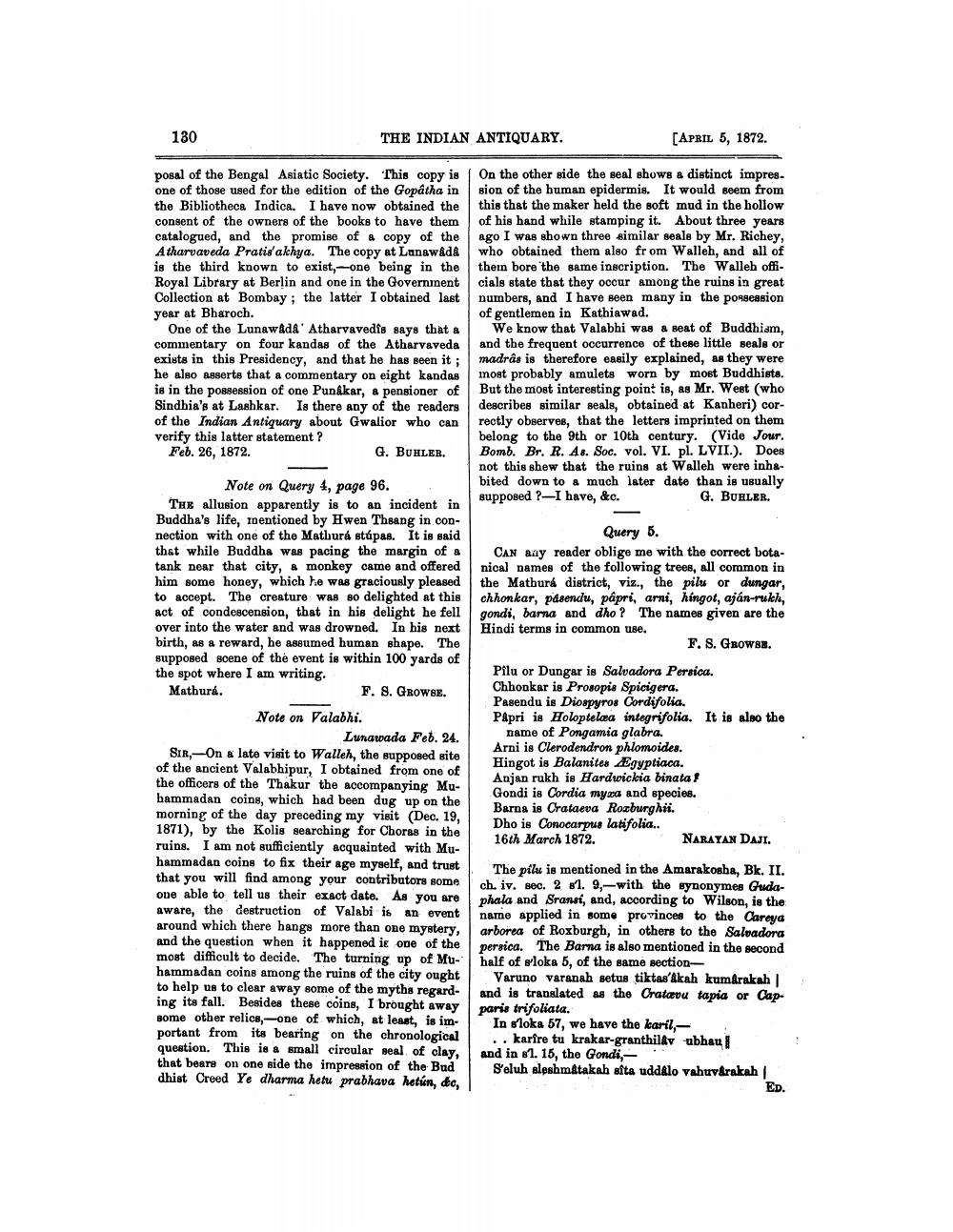________________
130
posal of the Bengal Asiatic Society. This copy is one of those used for the edition of the Gopâtha in the Bibliotheca Indica. I have now obtained the consent of the owners of the books to have them catalogued, and the promise of a copy of the Atharvaveda Pratis'akhya. The copy at Lunawada is the third known to exist,-one being in the Royal Library at Berlin and one in the Government Collection at Bombay; the latter I obtained last year at Bharoch.
THE INDIAN ANTIQUARY.
One of the Lunawada Atharvavedîs says that a commentary on four kandas of the Atharvaveda exists in this Presidency, and that he has seen it; he also asserts that a commentary on eight kandas is in the possession of one Punâkar, a pensioner of Sindhia's at Lashkar. Is there any of the readers of the Indian Antiquary about Gwalior who can verify this latter statement?
Feb. 26, 1872.
G. BUHLER.
Note on Query 4, page 96. THE allusion apparently is to an incident in Buddha's life, mentioned by Hwen Thsang in connection with one of the Mathurá stúpas. It is said that while Buddha was pacing the margin of a tank near that city, a monkey came and offered him some honey, which he was graciously pleased to accept. The creature was so delighted at this act of condescension, that in his delight he fell over into the water and was drowned. In his next birth, as a reward, he assumed human shape. The supposed scene of the event is within 100 yards of the spot where I am writing.
Mathura.
F. S. GROWSE.
[APRIL 5, 1872.
| On the other side the seal shows a distinct impression of the human epidermis. It would seem from this that the maker held the soft mud in the hollow of his hand while stamping it. About three years ago I was shown three similar seals by Mr. Richey, who obtained them also from Walleh, and all of them bore the same inscription. The Walleh officials state that they occur among the ruins in great numbers, and I have seen many in the possession of gentlemen in Kathiawad.
Note on Valabhi.
Lunawada Feb. 24. SIR,-On a late visit to Walleh, the supposed site of the ancient Valabhipur, I obtained from one of the officers of the Thakur the accompanying Muhammadan coins, which had been dug up on the morning of the day preceding my visit (Dec. 19, 1871), by the Kolis searching for Choras in the ruins. I am not sufficiently acquainted with Muhammadan coins to fix their age myself, and trust that you will find among your contributors some one able to tell us their exact date. As you are aware, the destruction of Valabi is an event around which there hangs more than one mystery, and the question when it happened is one of the most difficult to decide. The turning up of Muhammadan coins among the ruins of the city ought to help us to clear away some of the myths regarding its fall. Besides these coins, I brought away some other relics,-one of which, at least, is important from its bearing on the chronological question. This is a small circular seal of clay, that bears on one side the impression of the Bud dhist Creed Ye dharma hetu prabhava hetún, &c,
We know that Valabhi was a seat of Buddhism, and the frequent occurrence of these little seals or madrâs is therefore easily explained, as they were most probably amulets worn by most Buddhists. But the most interesting point is, as Mr. West (who describes similar seals, obtained at Kanheri) correctly observes, that the letters imprinted on them belong to the 9th or 10th century. (Vide Jour. Bomb. Br. R. As. Soc. vol. VI. pl. LVII.). Does not this shew that the ruins at Walleh were inhabited down to a much later date than is usually G. BUHLER. supposed ?—I have, &c.
Query 5.
CAN any reader oblige me with the correct botanical names of the following trees, all common in the Mathurá district, viz., the pilu or dungar, chhonkar, pásendu, pâpri, arni, hingot, aján-rukh, gondi, barna and dho? The names given are the Hindi terms in common use.
F. S. GROWSE.
Pilu or Dungar is Salvadora Persica. Chhonkar is Prosopis Spicigera. Pasendu is Diospyros Cordifolia.
Pâpri is Holoptelaa integrifolia. It is also the
name of Pongamia glabra. Arni is Clerodendron phlomoides. Hingot is Balanites Egyptiaca. Anjan rukh is Hardwickia binata! Gondi is Cordia myza and species. Barna is Crataeva Roxburghii. Dho is Conocarpus latifolia.. 16th March 1872.
NARAYAN DAJI.
The pilu is mentioned in the Amarakosha, Bk. II. ch. iv. sec. 2 81. 9,-with the synonymes Gudaphala and Sransí, and, according to Wilson, is the name applied in some provinces to the Careya arborea of Roxburgh, in others to the Salvadora persica. The Barna is also mentioned in the second half of sloka 5, of the same section
Varuno varanah setus tiktas'âkah kumarakah | and is translated as the Cratavu tapia or Capparis trifoliata.
In sloka 57, we have the karil,.. karîre tu krakar-granthilav ubhau and in 81. 15, the Gondi,
S'eluh aleshmatakah afta uddálo vahuvarakah |
ED.




